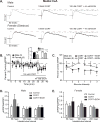Sex differences in responses of the basolateral-central amygdala circuit to alcohol, corticosterone and their interaction
- PMID: 27899281
- PMCID: PMC5372203
- DOI: 10.1016/j.neuropharm.2016.11.021
Sex differences in responses of the basolateral-central amygdala circuit to alcohol, corticosterone and their interaction
Abstract
Alcohol use disorders are chronically relapsing conditions that pose significant health challenges for our society. Stress is a prevalent trigger of relapse, particularly for women, yet the mechanisms by which alcohol and stress interact, and how this differs between males and females, remain poorly understood. The glutamatergic circuit connecting the basolateral (BLA) and central (CeA) nuclei of the amygdala is a likely locus for such adaptations, yet the impact of alcohol, corticosterone and their interaction on this circuit has been understudied. In particular, no studies have addressed sex differences in these effects or potential differential responses between the lateral and medial subdivisions of the central nucleus. Thus, we assessed the effects of alcohol and corticosterone treatments on BLA-evoked compound glutamatergic responses in medial and lateral CeA neurons from male and female rats. We observed minimal differences between medial and lateral CeA responses to alcohol and corticosterone in male rats, which were primarily sensitive to alcohol-induced inhibition of glutamatergic postsynaptic potentials. Unlike male neurons, cells from female rats displayed reduced sensitivity to alcohol's inhibitory effects. In addition, female neurons diverged in their sensitivity to corticosterone, with lateral CeA neuronal responses significantly blunted following corticosterone treatment and medial CeA neurons largely unchanged by corticosterone or subsequent co-application of alcohol. Together these data highlight striking differences in how male and female amygdala respond to alcohol and the stress hormone corticosterone, factors which may impact differential susceptibility of the sexes to alcohol- and stress-related disorders.
Keywords: Amygdala; Electrophysiology; Ethanol; Sex differences; Stress.
Copyright © 2016 Elsevier Ltd. All rights reserved.
Figures






References
-
- Aggleton JP, editor. The Amygdala: A Functional Analysis. Oxford University Press; 2000.
-
- Atkinson HC, Waddell BJ. Circadian variation in basal plasma corticosterone and adrenocorticotropin in the rat: sexual dimorphism and changes across the estrous cycle. Endocrinology. 1997;138:3842–3848. - PubMed
-
- Cassell MD, Freedman LJ, Shi C. The intrinsic organization of the central extended amygdala. Ann N Y Acad Sci. 1999;877:217–241. - PubMed
-
- Cassell MD, Gray TS. Morphology of peptide-immunoreactive neurons in the rat central nucleus of the amygdala. J Comp Neurol. 1989;281:320–333. - PubMed
Publication types
MeSH terms
Substances
Grants and funding
LinkOut - more resources
Full Text Sources
Other Literature Sources

